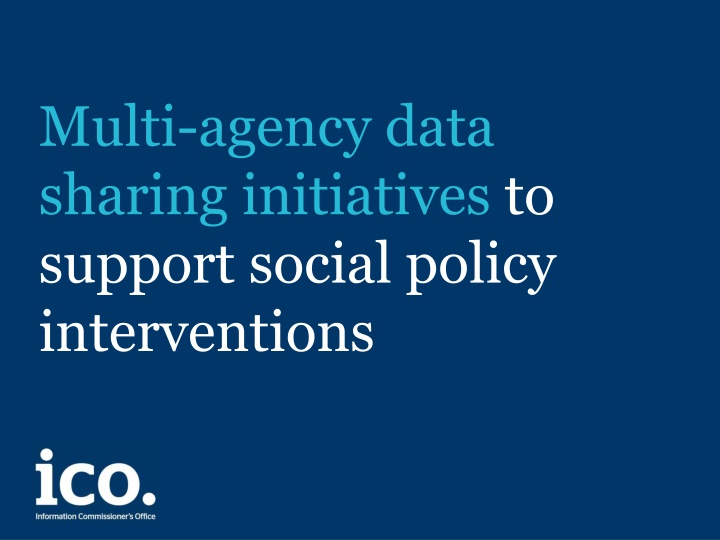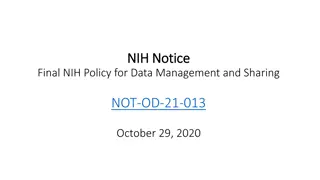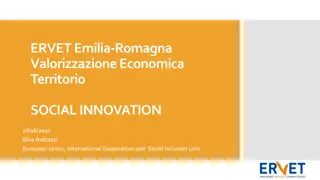Multi-Agency Data Sharing Initiatives for Social Policy Support
The presentation focuses on multi-agency data sharing initiatives for social policy interventions involving various organizations, with phases including evaluation, intervention, and identification. Key considerations involve addressing critical social needs while carefully managing data protection risks, emphasizing the importance of privacy impact assessments.
Download Presentation

Please find below an Image/Link to download the presentation.
The content on the website is provided AS IS for your information and personal use only. It may not be sold, licensed, or shared on other websites without obtaining consent from the author.If you encounter any issues during the download, it is possible that the publisher has removed the file from their server.
You are allowed to download the files provided on this website for personal or commercial use, subject to the condition that they are used lawfully. All files are the property of their respective owners.
The content on the website is provided AS IS for your information and personal use only. It may not be sold, licensed, or shared on other websites without obtaining consent from the author.
E N D
Presentation Transcript
Multi-agency data sharing initiatives to support social policy interventions
Troubled Families Overview The focus of this presentation is data sharing initiatives involving multiple organisations. These may involve only public bodies or a mix of public, private and not-for- profit organisations. Examples include: Complex Dependencies Working Well MASH DASH
We have identified three phases in a typical multi-agency data sharing initiative: Evaluation Intervention Identification
Identification At this phase, data from different sources is collated and analysed to identify potential candidates (e.g. individuals or families) eligible for intervention. The pool of personal data is generally larger at this phase than in the subsequent phases.
Intervention This is where the policy is actually implemented, usually through direct contact with individuals or families. Data processing focuses on the participants in the intervention.
Evaluation Here is where data about individuals participating in the project is analysed to assess the intervention. Generally the aim here is to assess value for money and the effectiveness of the intervention so processing may include data from those who did not receive the intervention.
Key considerations for these projects.
These are often important projects addressing critical social needs, like poverty alleviation and safeguarding children. However, from a data protection perspective it is less about the project and more about the processing. Data protection isn t a barrier to lawful sharing but it asks you to carefully consider the risks to individuals privacy.
Conducting a privacy impact assessment can help you think about the privacy risks at each phase and how you will comply with the Data Protection Act. With careful consideration in a privacy impact assessment, the intervention and evaluation phases can often be designed in a way that complies with the Data Protection Act (DPA).
Often these data sharing projects are treated as a single initiative in PIAs. However, the three phases need to be distinguished from one another as there are unique data protection considerations and challenges for each. From a data processing perspective each phase is distinctly different. Therefore, your legal basis, scheduled conditions and possibly you privacy risks could be different.
While the first and third phases could be considered research , they are unlikely to be classified as such for the purposes of the DPA exemption. This is because the data is generally processed to support measures or decisions with respect to particular individuals. The second phase (intervention) is likely to be slightly more challenging from a DPA perspective .
Challenges at the intervention phase
Fairness considerations For example, would it be within an individuals reasonable expectation to process the data in this way? How will you inform individuals whose data is being processed? The DPA does not prescribe how you provide this information; but unless an exemption applies, you need to make fair processing information available.
Data quality Consider data quality and the risks associated with processing inaccurate data. For example, what happens if individuals are identified as at risk based on inaccurate data?
Legal gateway What is your legal basis for processing? Do all organisations involved have the legal basis to share?
Consider what data you need and why With analytics technology, it is tempting to use as much information as possible and about as many people as possible, but this could be excessive. At the same time, you will want to make sure your data set is adequate to identify eligible participants. Consider why is each piece of data needed for your stated purpose and whose data you actually need to process at this phase?
Schedule 2 and 3 conditions What schedule 2 can you rely on for this specific identification activity? If you are processing sensitive personal data, what schedule 3 condition can each organisation rely on?
Think about retention Not everyone whose data is processed will require intervention. What will you do with their data when this phase is finished?
For more information Read our guide to the Data Protection Act Subscribe to our e-newsletter at www.ico.org.uk or find us on \\child.indigo.local\profiles\desktop\covellj\Desktop\Various images and designs\fb twitter logos\twitter_newbird_blue.png youtube LinkedIn_logo























